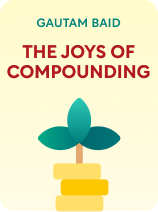

This article is an excerpt from the Shortform book guide to "The Joys Of Compounding" by Gautam Baid. Shortform has the world's best summaries and analyses of books you should be reading.
Like this article? Sign up for a free trial here.
Are you worried about losing money from investing in a failing market? How can you manage financial risk?
In The Joys of Compounding, Gautam Baid advises mitigating potential losses by mastering risk management. In a landscape teeming with unpredictability, safeguarding your investments is essential.
Learn how to manage financial risk so you remain shielded against unforeseen market downturns.
Risk Management
Baid offers the following recommendations to learn how to manage financial risk:
Anticipate various outcomes: Actively prepare for both success and failure, even in seemingly stable markets. This proactive stance protects against over-reliance on a particular asset or sector and ensures you’re not caught off-guard by market shifts.
(Shortform note: Nassim Nicholas Taleb (Antifragile) offers practical advice for preparing for both success and failure: Visualize your investment portfolio as a barbell, with one side representing safe, low-profit investments and the other side representing risky, potentially high-profit investments. Taleb suggests you can strike a balance between safeguarding your assets and prepping for successful outcomes by placing the majority of your investments on the safe side of the barbell and allocating the rest to the risky side. This way, you can only ever lose the small portion of the money you’ve risked—but could earn a lot more.)
Invest in familiar terrain: Allocate funds to sectors or industries you understand well to diminish the risk of making ill-informed choices based on market hype or misconceptions. (Shortform note: Peter Lynch (One Up on Wall Street) emphasizes this idea, suggesting you consider companies you encounter in your daily life and work as investment opportunities. Companies you have personal or work-related experience with are likely to be the ones you understand the best. For example, if a brand of fitness equipment at your gym impresses you, you already have a strong knowledge of that company. Similarly, if a software stands out in your profession, you have inside knowledge of that company.)
Minimize overhead costs: Be mindful of fees and taxes associated with your investments to ensure they don’t diminish your returns. (Shortform note: Burton Malkiel, (A Random Walk Down Wall Street) suggests you can minimize overhead costs by selecting a financial adviser with a low expense ratio—meaning less of your investments go toward paying your adviser—and a low turnover rate—meaning you’re buying and selling stocks less frequently, which decreases your tax liability.)
Diversify strategically: Distribute your investments across various sectors to shield against substantial losses from a single asset’s underperformance. However, strive for a balanced approach and avoid over-diversifying, as this approach can dilute potential returns.
(Shortform note: Financial experts suggest that the most effective way to strike the right diversification balance is to limit the number of stocks in your portfolio. They explain that while diversifying across a vast number of stocks minimizes risk, it simultaneously dilutes the impact of any single high-performing stock. For example, in a portfolio consisting of hundreds of stocks, a few stocks performing exceptionally well would barely impact your returns because they would only represent a small share of your total portfolio. On the other hand, in a portfolio of only 20 stocks, those high performers would significantly enhance your overall returns.)
Demand transparency: Prioritize businesses that favor clear communication in executive correspondence and financial reports. Such clarity often indicates trustworthy management and reduces the risk of unexpected issues or questionable tactics affecting your investments.
(Shortform note: Financial experts add to this, suggesting that complex or convoluted documents may mask vital details that impact your investments. In addition to demanding transparency from the companies you invest in, they recommend seeking clarity from other sources to validate the information you receive. A prudent approach would be to cross-reference and corroborate a company’s financial statements with official documents from regulatory authorities, such as the US Securities and Exchange Commission.)
Buy low-priced stocks: Purchase assets when their market price is below their estimated value to create a margin of safety. This buffer guards against unforeseen market downturns and helps reduce potential losses. (Shortform note: Howard Marks (The Most Important Thing) offers practical advice for buying low-priced stocks: Look for three conditions that might lead the market and other investors to undervalue stocks: 1) The stock’s price has seen a rapid decline, deterring average investors. 2) It possesses a noticeable flaw or drawback, making it less enticing to investors. 3) It’s widely perceived as a bad investment, so doesn’t attract significant capital.)

———End of Preview———
Like what you just read? Read the rest of the world's best book summary and analysis of Gautam Baid's "The Joys Of Compounding" at Shortform.
Here's what you'll find in our full The Joys Of Compounding summary:
- Why compounding isn't just a financial concept, but a transformative principle
- Strategies for compounding your well-being and happiness
- How to achieve steady and sustainable financial growth






